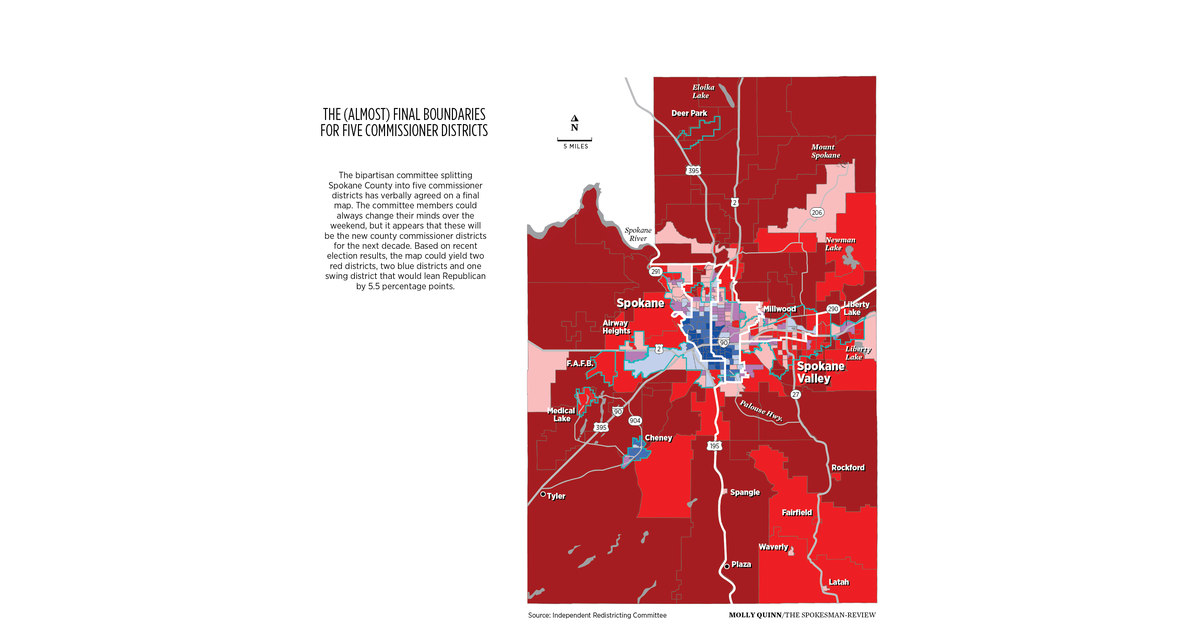
The Spokane County Redistricting Commission temporarily hit a wall last week at an unexpected spot in the road to 2022.
Having reached a compromise on where to draw the lines on the new five-commissioner district map, it tied itself briefly into a knot over which commissioners would get to serve four years after winning their race next year and which would only get a two-year term.
Redistricting commissioners could’ve avoided that by taking a page from Spokane’s history.
Republicans on the commission wanted a district that includes the West Plains, other parts of west and south Spokane County, and parts of the City of Spokane to get a four-year term, while Democrats on the commission thought it should be a two-year term.
That district, currently numbered 5, is thought to be the most competitive of the five based on the Republican-Democratic voting results in several past elections. Two other districts, which include Spokane Valley and most rural areas of eastern and northern Spokane County, are ruby red; the remaining two, which carve up the City of Spokane and some of its surrounding suburbs, are definitely blue – albeit a slightly lighter shade than those other two districts are red.
By comparison, District 5 as drawn Thursday was Republican, but less so than either of the two eastern districts, and less red than the two Democratic districts are blue. But GOP candidates enjoyed a 5.5% advantage based on some calculations, so it’s competitive, but hard to call it a true swing district.
District 5 is also – accidentally or not, depending on whom you ask – the district where current County Commissioner Al French resides and would have to seek re-election, should he decide to continue his service on the board. To say that French is not a fan of the five-member, “elect ’em by district” commissioner system is an understatement.
Thursday, the disagreement over whether District 5 should get an initial two- or four-year term threatened to derail the whole process. A deadlock on the that point could have sent the whole effort to the state redistricting commission, which could have redrawn the map, as well as determined how long the commissioners served. On Friday, the county redistricting commission reached a compromise, giving District 5 a two-year term, but making it slightly less competitive for Democrats, so that the GOP advantage by some calculations is now 6%.
The commission could have avoided this debate entirely by doing what Spokane did 62 years ago when it set up new city council districts. The city was dumping its old five-commissioner system for a government with a city manager, mayor and six council members. The council seats were to be staggered with four-year terms, but all six were being elected for their first term in 1960.
The city decided to give the three candidates with the most votes the four-year terms, and the three with fewer votes the two-year terms. Those with less support had to go before voters again sooner.
The redistricting commission could have given the two winning candidates with the most total votes four-year terms, and the other three winning candidates two-year terms. That would have given 2022 candidates even more incentive to find and turn out their voters.
It would likely mean those ruby-red east districts wouldn’t have to run again until 2026 and have coveted spots in future mid-term elections, which have lower turnout and most years can benefit established incumbents. The two-year terms would likely go to the two blue districts and the supposed swing district, meaning those seats would be up in presidential years when turnout is higher and the chance of a bigger shift is possible.
Under the 2018 law that created the five-commissioner system, such a division would have been possible, said Rep. Marcus Riccelli, the prime sponsor of the bill that became law.
“It says (terms) have to be staggered. It does not say how,” Riccelli said. Although he added he’s been trying to stay away from the redistricting debate as much as possible, “I think it’s better the decision is made locally.”
The redistricting commission’s Friday compromise keeps the decision local, so it seems unlikely members would reopen the debate, even if they thought this was a fairer way to divvy up terms.
About those phone prefixes …
Several alert readers called or wrote to correct a mistake in last week’s column about Spokane’s old phone prefixes.
The column incorrectly said the letters in old 92 prefix attached to many landlines in Spokane Valley stood for Valley. This was wrong on several counts because the exchange was really Walnut and, as several readers pointed out, 92 couldn’t have used a V because it is assigned to 8.
Another reader said she remembered the 62 exchange as MAdison, not MAin as the column listed. It apparently depends on what era is being discussed. It was MAin in the ’40s and ’50s, but seems to have shifted over to Madison, at least for some exchanges starting with 62, by the ’60s.
"control" - Google News
October 17, 2021 at 07:10AM
https://ift.tt/3vjXw3O
Spin Control: Here's a fairer way to set terms for the new commissioner districts - The Spokesman Review
"control" - Google News
https://ift.tt/3bY2j0m
https://ift.tt/2KQD83I
Bagikan Berita Ini















0 Response to "Spin Control: Here's a fairer way to set terms for the new commissioner districts - The Spokesman Review"
Post a Comment